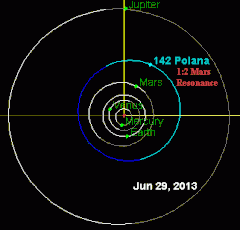astro.wikisort.org - Asteroid
Polana (minor planet designation: 142 Polana) is a very dark asteroid from the asteroid belt. It was discovered by Johann Palisa on January 28, 1875, and named after the city of Pola (now Pula, Croatia), home of the Austrian Naval Observatory where he made the discovery.[1]
 Polana is in a 1:2 resonance with Mars | |
| Discovery[1] | |
|---|---|
| Discovered by | J. Palisa |
| Discovery site | Austrian Naval Obs. |
| Discovery date | 28 January 1875 |
| Designations | |
MPC designation | (142) Polana |
| Pronunciation | [citation needed] |
Named after | Pula |
Alternative designations | A875 BA; 1923 WA; 1954 BH; 1956 XZ; 1963 SA |
Minor planet category | Asteroid belt |
| Orbital characteristics[1] | |
| Epoch 31 July 2016 (JD 2457600.5) | |
| Uncertainty parameter 0 | |
| Observation arc | 117.65 yr (42971 d) |
| Aphelion | 2.7444 AU (410.56 Gm) |
| Perihelion | 2.0934 AU (313.17 Gm) |
Semi-major axis | 2.4189 AU (361.86 Gm) |
| Eccentricity | 0.13457 |
Orbital period (sidereal) | 3.76 yr (1374.1 d) |
Average orbital speed | 19.07 km/s |
Mean anomaly | 140.92° |
Mean motion | 0° 15m 43.128s / day |
| Inclination | 2.2379° |
Longitude of ascending node | 291.27° |
Argument of perihelion | 292.00° |
| Physical characteristics | |
| Dimensions | 55.29±1.6 km[1] 55.3 ± 1.6[2] |
Synodic rotation period | 9.764 h (0.4068 d) |
Geometric albedo | 0.0451±0.003[1] 0.045 ± 0.003[2] |
Spectral type | F/B[1] B−V=0.621±0.022[1] U−B=0.236±0.035[1] |
Absolute magnitude (H) | 10.27[1] |
It is a major member of the eponymously named Polana family, which is a subgroup of the Nysa family.[3] The asteroid has an estimated diameter of about 55.3 km and a low albedo of 0.045.[2] It is orbiting at a distance of 2.419 times the separation of the Earth from the Sun, with an orbital period of 3.76 years and an eccentricity of 0.14.
In the Tholen classification scheme, Polana is a primitive carbonaceous asteroid of type F, which is a subdivision of more common C-type.[1] Under the SMASS classification taxonomy, Polana is listed as a B-type asteroid; a group that combines both the Tholen B and F types. The spectrum of this object suggests the presence of magnetite (Fe3O4), which gives it the spectrally blue coloration that is a characteristic of this SMASS class.[4]
![Origin of 162173 Ryugu may be either 495 Eulalia or 142 Polana[5].mw-parser-output .legend{page-break-inside:avoid;break-inside:avoid-column}.mw-parser-output .legend-color{display:inline-block;min-width:1.25em;height:1.25em;line-height:1.25;margin:1px 0;text-align:center;border:1px solid black;background-color:transparent;color:black}.mw-parser-output .legend-text{} Sun · Earth · 162173 Ryugu · 142 Polana · 495 Eulalia](http://upload.wikimedia.org/wikipedia/commons/thumb/7/71/Animation_of_162173_Ryugu%2C_495_Eulalia_and_142_Polana.gif/220px-Animation_of_162173_Ryugu%2C_495_Eulalia_and_142_Polana.gif)
Sun · Earth · 162173 Ryugu · 142 Polana · 495 Eulalia
Mars resonance
Polana is in a 1:2 orbital resonance with Mars, meaning that Polana orbits the Sun once for every two orbits that Mars completes. This resonance helps protect the asteroid from orbital erosion: the orbital eccentricities of the resonant asteroids are clearly greater than the non-resonant asteroids. There is a peak in the number of asteroids located at 2.419 AU from the Sun.[6] In spite of strong perturbations caused by the passing of both Jupiter and Mars, the 1:2 Mars resonance brings about stability for billions of years. There are up to 1,500 asteroids in this resonance, and the resonance between Polana and Mars will strengthen over the next million years due to Polana transitioning into a strong libration period with Mars.[7]
References
- "142 Polana". JPL Small-Body Database Browser. August 14, 2007. Retrieved May 12, 2016.
- Lazzarin, M.; Barbieri, C.; Barucci, M. A. (December 1995), "Visible Spectroscopy of Dark, Primitive Asteroids", Astronomical Journal, 110: 3058, Bibcode:1995AJ....110.3058L, doi:10.1086/117747
- Cellino, A.; et al. (August 2001). "The Puzzling Case of the Nysa-Polana Family". Icarus. 152 (2): 225–237. Bibcode:2001Icar..152..225C. doi:10.1006/icar.2001.6634.
- Yang, Bin; Jewitt, David (September 2010), "Identification of Magnetite in B-type Asteroids", The Astronomical Journal, 140 (3): 692–698, arXiv:1006.5110, Bibcode:2010AJ....140..692Y, doi:10.1088/0004-6256/140/3/692, S2CID 724871
- S. Sugita; et al. (March 19, 2019). "The geomorphology, color, and thermal properties of Ryugu: Implications for parent-body processes". Science. 364 (6437): eaaw0422. Bibcode:2019Sci...364..252S. doi:10.1126/science.aaw0422. hdl:1893/29363. PMC 7370239. PMID 30890587.
- Gallardo, Tabaré (2007). "A new population of asteroids: the resonants 1:2 with Mars". Montevideo, Uruguay: Institute of Physics, Faculty of Sciences. Retrieved December 17, 2009.
- Gallardo, Tabaré (2009). "A New Dynamical Population of Asteroids" (PDF). Revista Mexicana de Astronomía y Astrofísica, Serie de Conferencias. 35: 21–22. Bibcode:2009RMxAC..35...21G. Retrieved December 17, 2009.
External links
- Asteroids inside the resonance 1:2 with Mars, Tabaré Gallardo
- 142 Polana at AstDyS-2, Asteroids—Dynamic Site
- 142 Polana at the JPL Small-Body Database
На других языках
[de] (142) Polana
(142) Polana ist ein Asteroid des Asteroiden-Hauptgürtels, der am 28. Januar 1875 von Johann Palisa entdeckt wurde. Palisa entdeckte den Asteroiden an der Marinesternwarte von Pula (it. Pola) und benannte ihn nach diesem Ort.- [en] 142 Polana
[es] (142) Polana
(142) Polana es un asteroide perteneciente al cinturón de asteroides descubierto el 28 de enero de 1875 por Johann Palisa desde el observatorio de Pula, Croacia.[2] Está nombrado por el lugar del descubrimiento.[3][fr] (142) Polana
(142) Polana est un astéroïde de la ceinture principale découvert par Johann Palisa le 28 janvier 1875.[ru] (142) Пулана
(142) Пулана (нем. Polana) — является довольно большим и очень тёмным астероидом главного пояса, принадлежащим к редкому спектральному классу F. Он был открыт 28 января 1875 года австрийским астрономом Иоганном Пализой в обсерватории Пула и назван в честь австрийского города Пула, вблизи которого она находится[1]. Он является одним из главных представителей семейства Нисы[2].Другой контент может иметь иную лицензию. Перед использованием материалов сайта WikiSort.org внимательно изучите правила лицензирования конкретных элементов наполнения сайта.
WikiSort.org - проект по пересортировке и дополнению контента Википедии